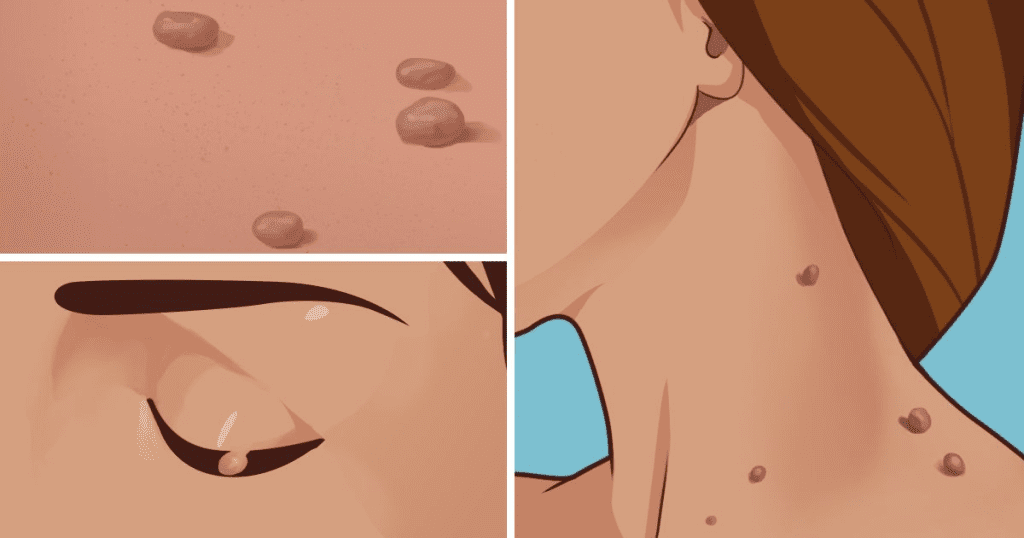Skin tags are small, benign growths that often appear in areas where the skin creases or rubs against clothing, such as the neck, armpits, or eyelids. While they are harmless, many people find them unsightly and seek ways to remove them. Dr. Doug Willen, a well-known expert in natural health remedies, has shared a simple and effective way to remove skin tags using apple cider vinegar. His method has gained millions of views and popularity for its ease and effectiveness. In this article, we’ll explore how to use apple cider vinegar to safely and effectively remove skin tags at home.
What Are Skin Tags and Why Do They Occur?

Before diving into the apple cider vinegar method, it’s important to understand what skin tags are and why they occur. According to Medicine Net, skin tags, also known as acrochordons, are small, soft, skin-colored growths that form mainly in areas where the skin experiences friction, such as the neck, underarms, groin, and eyelids.
- Causes of Skin Tags: Skin tags are more common in adults and can be linked to factors such as genetics, obesity, and diabetes. They often develop in skin folds where friction occurs.
- Are Skin Tags Harmful?: Skin tags are harmless and usually painless, but they can cause discomfort if irritated by clothing or jewelry. Some people opt to remove them for cosmetic reasons.
Why Apple Cider Vinegar?
Apple cider vinegar has been a popular home remedy for various skin conditions for centuries. Its natural acidity, due to the presence of acetic acid, is believed to help break down the tissue of the skin tag, causing it to gradually fall off. The method proposed by Dr. Doug Willen is simple and non-invasive, making it an appealing alternative to medical procedures such as freezing, cutting, or burning.
Here are the benefits of using apple cider vinegar for skin tag removal:
- Cost-effective: Apple cider vinegar is an affordable solution compared to professional dermatological procedures.
- Natural and Non-invasive: It provides a chemical-free alternative to other treatments.
- Readily Available: You can find apple cider vinegar in most grocery stores, making it an accessible remedy.
How to Safely Use Apple Cider Vinegar for Skin Tag Removal
If you’re ready to try this natural remedy, follow these steps carefully to ensure a safe and effective process.
1. Gather Your Supplies
You’ll need the following items to get started:
- Apple cider vinegar (preferably organic)
- Cotton balls or pads
- Bandage or medical tape
- A mild soap for cleaning the area
- Water for rinsing
2. Clean the Affected Area

Before applying apple cider vinegar, make sure the area around the skin tag is clean. Use mild soap and water to gently wash the area, and then pat it dry. This step helps reduce the risk of infection and allows the vinegar to work more effectively on the skin tag.
3. Apply the Apple Cider Vinegar
Soak a cotton ball or pad in apple cider vinegar until it is fully saturated. Squeeze out any excess liquid to avoid dripping. Gently press the soaked cotton onto the skin tag.
- Secure It in Place: Use a bandage or medical tape to secure the cotton ball over the skin tag. This ensures that the vinegar stays in contact with the skin tag, allowing it to penetrate and begin breaking down the tissue.
- Leave It On: Ideally, leave the apple cider vinegar on the skin tag for several hours or overnight. For best results, repeat the application daily.
4. Monitor Your Progress
The apple cider vinegar method can take anywhere from a few days to a couple of weeks to show results, depending on the size and location of the skin tag. As you continue applying the vinegar, you’ll notice that the skin tag may darken and eventually dry out.
- Skin Tag Turns Dark: This is a sign that the vinegar is working. The skin tag will gradually shrink and eventually fall off.
- Continue Daily Applications: Keep applying the vinegar each day until the skin tag falls off completely.
5. Care for the Area After the Skin Tag Falls Off

Once the skin tag falls off, it’s important to take care of the skin in that area to prevent irritation or infection.
- Clean the Area: Gently clean the area with mild soap and water.
- Apply a Healing Ointment: You can use a mild antibacterial ointment or aloe vera gel to soothe the skin and promote healing.
- Avoid Scratching or Irritating the Skin: Allow the area to heal naturally without picking or scratching.
Benefits of Using Apple Cider Vinegar for Skin Tag Removal
Dr. Willen’s apple cider vinegar method has grown in popularity due to its simplicity and effectiveness. Here are some of the key benefits people experience with this home remedy:
- Pain-Free Process: Unlike freezing or cutting methods, using apple cider vinegar is virtually painless. Some people may experience mild stinging or irritation, but it’s generally considered a gentle approach.
- No Scarring: When done correctly, apple cider vinegar can remove skin tags without leaving noticeable scars.
- All-Natural Solution: For those looking to avoid chemical-based treatments, apple cider vinegar offers a natural, non-toxic way to remove skin tags.
Potential Risks and Precautions

While using apple cider vinegar for skin tag removal is generally considered safe, there are a few precautions to keep in mind:
- Skin Sensitivity: Some individuals may have sensitive skin that reacts to the acidity of apple cider vinegar. If you experience redness, burning, or irritation, discontinue use immediately.
- Avoid Broken Skin: Never apply apple cider vinegar to broken or irritated skin, as this can cause further irritation or even infection.
- Consult a Doctor: If your skin tag changes in size, shape, or color, it’s important to consult a dermatologist to rule out more serious skin conditions, such as skin cancer.
Conclusion: A Simple, Natural Solution for Skin Tags
Dr. Doug Willen’s apple cider vinegar method offers a safe, natural, and effective way to remove skin tags at home. By following these steps carefully, you can successfully eliminate unwanted skin tags without the need for invasive procedures. However, always approach home remedies with caution, especially if you have sensitive skin or underlying health concerns. If in doubt, consult a healthcare professional before beginning any new treatment. With the right care, you can achieve smooth, tag-free skin in a cost-effective and natural way.


